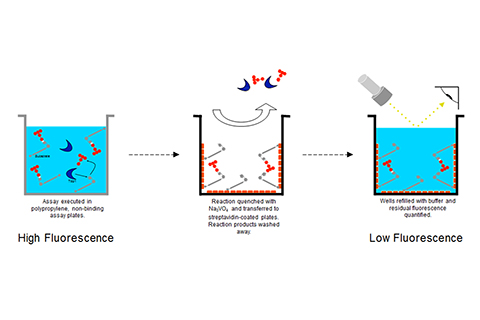
The new assay. Left: DNA strands (gray) connected to eosin (red) are introduced to TDP1 (dark blue) and TDP1 inhibitors. Center: Uninhibited TDP1 cleaves eosin and removes the fluorescent signal before being washed away. Right: The strands are reexamined for fluorescent signals.
A team of scientists and specialists from NCI at Frederick, NCI at Bethesda, the Frederick National Laboratory for Cancer Research, and Data Management Services, Inc., has developed the first method for identifying natural products that could increase the effectiveness of camptothecin-based cancer treatments.
Camptothecin and its derivatives, such as irinotecan and topotecan, are alkaloids found in the Chinese Xi Shù tree that are used in the treatment of ovarian, colorectal, and small cell lung cancers. They work by targeting topoisomerase 1 (TOP1), a protein that binds to the phosphate spine of DNA, temporarily breaks it to relieve torsion, and repairs it once the strand is sufficiently relaxed.
However, in the presence of camptothecin, TOP1 can bind to and break DNA’s phosphate backing but cannot repair it, creating a damaged strand. Further, since TOP1 is programmed not to detach itself until the strand is repaired, it remains trapped on the DNA, adding a “bulge” and further damaging the strand. Once that happens to enough strands in a cell, the cell’s death cycle kicks in, which makes camptothecin-based TOP1 inhibition especially useful for killing cancer cells.
But the human body has a way to fix trapped TOP1—tyrosyl-DNA phosphodiesterase 1 (TDP1). TDP1 is an enzyme that can cut TOP1 off of the damaged DNA and begin repairing the strand, which prevents the damage from accumulating and keeps the cell alive. In healthy cells, this is fine, but in cancer cells, this significantly reduces the effectiveness of camptothecin treatments.
According to the study published by the assay’s creators, that makes identifying compounds that inhibit TDP1 crucial for improving TOP1-targeted therapy. While multiple attempts have been made to identify inhibitors in synthetic compounds, the authors believe that finding a way to identify naturally occurring inhibitors would open up another avenue for treatment and research.
And they have developed the world’s first assay to do just that.
The new method uses fluorescence to measure whether a natural product extract can inhibit TDP1. To begin, eosin, a red fluorescent tag, gets attached to one end of DNA strands that mimic TDP1’s binding site. The opposite ends are tagged with a biotin molecule, which anchors the strands to a well plate, allowing them to be washed with a buffer. TDP1 and a natural product extract are then introduced to the DNA before the strands’ fluorescence levels are measured.
Normally, TDP1 cuts off the eosin and removes most of the fluorescence along with it. However, if the included extract is a TDP1 inhibitor, TDP1 fails to cut the eosin and the fluorescent signal remains intact. Higher levels of fluorescence indicate higher levels of TDP1 inhibition.
The fluorescence measurement is accompanied by a buffer wash step that removes the cleaved fluorescent eosin particles, which prevents them from registering as false positives when TDP1 is not inhibited. Accuracy is also ensured by the use of bovine serum albumin and Tween detergent, which further reduce interference and false positives.
Extracts that test positive undergo another three-step test to either confirm or eliminate their roles as TPD1 inhibitors. Of the over 227,000 molecules, pre-fractionated extracts, and natural product extracts evaluated in the study, only 117 were confirmed as inhibitors—exclusiveness that is evidence of the assay’s effectiveness at reducing false positives.
“The assay design used in this report was made significantly more rigorous so as to provide useful data when assaying crude natural product extracts,” said the study’s senior investigator, Barry O’Keefe, Ph.D., chief, Natural Products Branch, Developmental Therapeutics Program, Division of Cancer Treatment and Diagnosis, and deputy chief, Molecular Targets Laboratory, Center for Cancer Research (CCR), NCI at Frederick. “These modifications can be adapted by other researchers for their screens using natural product extracts to improve their assay performance and the rigor of their results.”
Among the 117 newly identified TPD1 inhibitors are promising candidates to accompany camptothecin therapy, including plant extracts EHL and minquartynoic acid, as well as halenaquinone and halenaquinol sulfate, which are extracts from marine sponges. Halenaquinone and halenaquinol sulfate are especially promising because they can irreversibly inhibit TPD1 and prevent it from reactivating in cancer cells during therapy.
“The discovery of TDP1 inhibitors is just beginning, and our study reports the discovery of a novel series of inhibitors,” said Yves Pommier, M.D., Ph.D., chief, Developmental Therapeutics Branch and Laboratory of Molecular Pharmacology, CCR, NCI at Bethesda, who first proposed the assay along with his colleague, Christophe Marchand, Ph.D., staff scientist, Center for Research Strategy, NCI at Bethesda.
“We are pioneering the targeting of TDP1,” Pommier said. “Our laboratory published the first TDP1 inhibitors.”
The scientists admit that their studies are still early and that there is room for improvement, but they already have plans to expand their research to TDP2 inhibitors, and they anticipate future findings will build on their assay and the identified compounds.
“It is hoped that these results will lead to further optimization of these pharmacophores by medicinal chemists to provide more potent and drug-like molecules for potential development and adjunct therapies,” O’Keefe said.

